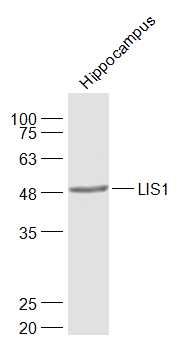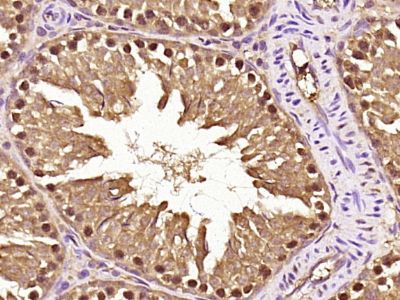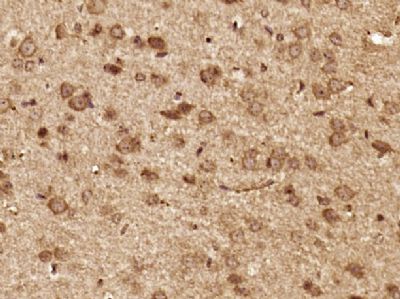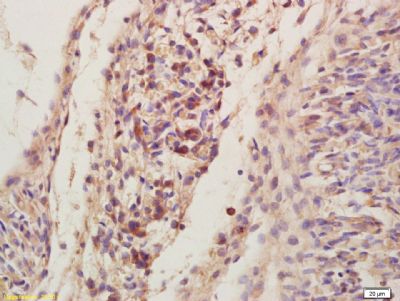无脑回的致病基因LIS1抗体
产品名称: 无脑回的致病基因LIS1抗体
英文名称: AQP9
产品编号: 2260
产品价格: null
产品产地: 上海
品牌商标: 雅吉
更新时间: null
使用范围: WB ELISA IHC-P IHC-F IF
上海雅吉生物科技有限公司
- 联系人 :
- 地址 : 上海市闵行区元江路5500号第1幢5658室
- 邮编 :
- 所在区域 : 上海
- 电话 : 158****3937 点击查看
- 传真 : 点击查看
- 邮箱 : yajikit@163.com
中文名称无脑回的致病基因LIS1抗体
别 名LIS 1; LIS 2; LIS-1; LIS1; LIS1_HUMAN; LIS2; Lissencephaly 1 protein; Lissencephaly-1 protein; MDCR; MDS; PAF acetylhydrolase 45 kDa subunit; PAF AH 45 kDa subunit; PAF AH alpha; PAF-AH 45 kDa subunit; PAF-AH alpha; PAFAH alpha; PAFAH; PAFAH1B1; PAFAHA; Platelet activating factor acetylhydrolase 1b regulatory subunit 1; Platelet activating factor acetylhydrolase isoform Ib alpha subunit; Platelet-activating factor acetylhydrolase IB subunit alpha.
研究领域细胞生物 神经生物学 信号转导
抗体来源Rabbit
克隆类型Polyclonal
交叉反应Mouse, Rat, (predicted: Human, )
产品应用WB=1:500-2000 ELISA=1:500-1000 IHC-P=1:100-500 IHC-F=1:100-500 IF=1:100-500 (石蜡切片需做抗原修复)
not yet tested in other applications.
optimal dilutions/concentrations should be determined by the end user.
分 子 量47kDa
细胞定位细胞核 细胞浆
性 状Liquid
浓 度1mg/ml
免 疫 原KLH conjugated synthetic peptide derived from human LIS1:311-410/410
亚 型IgG
纯化方法affinity purified by Protein A
储 存 液0.01M TBS(pH7.4) with 1% BSA, 0.03% Proclin300 and 50% Glycerol.
保存条件Shipped at 4℃. Store at -20 °C for one year. Avoid repeated freeze/thaw cycles.
PubMedPubMed
产品介绍Positively regulates the activity of the minus-end directed microtubule motor protein dynein. May enhance dynein-mediated microtubule sliding by targeting dynein to the microtubule plus end. Required for several dynein- and microtubule-dependent processes such as the maintenance of Golgi integrity, the peripheral transport of microtubule fragments and the coupling of the nucleus and centrosome. Required during brain development for the proliferation of neuronal precursors and the migration of newly formed neurons from the ventricular/subventricular zone toward the cortical plate. Neuronal migration involves a process called nucleokinesis, whereby migrating cells extend an anterior process into which the nucleus subsequently translocates. During nucleokinesis dynein at the nuclear surface may translocate the nucleus towards the centrosome by exerting force on centrosomal microtubules. Also required for proper activation of Rho GTPases and actin polymerization at the leading edge of locomoting cerebellar neurons and postmigratory hippocampal neurons in response to calcium influx triggered via NMDA receptors. May also play a role in other forms of cell locomotion including the migration of fibroblasts during wound healing. Non-catalytic subunit of an acetylhydrolase complex which inactivates platelet-activating factor (PAF) by removing the acetyl group at the SN-2 position.
Function:
Required for proper activation of Rho GTPases and actin polymerization at the leading edge of locomoting cerebellar neurons and postmigratory hippocampal neurons in response to calcium influx triggered via NMDA receptors. Non-catalytic subunit of an acetylhydrolase complex which inactivates platelet-activating factor (PAF) by removing the acetyl group at the SN-2 position (By similarity). Positively regulates the activity of the minus-end directed microtubule motor protein dynein. May enhance dynein-mediated microtubule sliding by targeting dynein to the microtubule plus end. Required for several dynein- and microtubule-dependent processes such as the maintenance of Golgi integrity, the peripheral transport of microtubule fragments and the coupling of the nucleus and centrosome. Required during brain development for the proliferation of neuronal precursors and the migration of newly formed neurons from the ventricular/subventricular zone toward the cortical plate. Neuronal migration involves a process called nucleokinesis, whereby migrating cells extend an anterior process into which the nucleus subsequently translocates. During nucleokinesis dynein at the nuclear surface may translocate the nucleus towards the centrosome by exerting force on centrosomal microtubules. May also play a role in other forms of cell locomotion including the migration of fibroblasts during wound healing.
Subunit:
Component of cytosolic PAF-AH IB, which is composed of PAFAH1B1 (alpha), PAFAH1B2 (beta) and PAFAH1B3 (gamma) subunits. Trimer formation is not essential for the catalytic activity of the enzyme which is contributed solely by the PAFAH1B2 (beta) and PAFAH1B3 (gamma) subunits. Interacts with IQGAP1, KATNB1 and NUDC. Interacts with DAB1 when DAB1 is phosphorylated in response to RELN/reelin signaling (By similarity). Can self-associate. Interacts with DCX, dynein, dynactin, NDE1, NDEL1 and RSN. Interacts with DISC1, and this interaction is enhanced by NDEL1. Interacts with ASUN.
Subcellular Location:
Cytoplasm, cytoskeleton. Cytoplasm, cytoskeleton, centrosome. Cytoplasm, cytoskeleton, spindle (By similarity). Nucleus membrane (Potential). Note=Redistributes to axons during neuronal development. Also localizes to the microtubules of the manchette in elongating spermatids and to the meiotic spindle in spermatocytes (By similarity). Localizes to the plus end of microtubules and to the centrosome. May localize to the nuclear membrane.
Tissue Specificity:
Fairly ubiquitous expression in both the frontal and occipital areas of the brain.
DISEASE:
Lissencephaly 1 (LIS1) [MIM:607432]: A classical lissencephaly. It is characterized by agyria or pachygyria and disorganization of the clear neuronal lamination of normal six-layered cortex. The cortex is abnormally thick and poorly organized with 4 primitive layers. Associated with enlarged and dysmorphic ventricles and often hypoplasia of the corpus callosum. Note=The disease is caused by mutations affecting the gene represented in this entry.
Subcortical band heterotopia (SBH) [MIM:607432]: SBH is a mild brain malformation of the lissencephaly spectrum. It is characterized by bilateral and symmetric plates or bands of gray matter found in the central white matter between the cortex and cerebral ventricles, cerebral convolutions usually appearing normal. Note=The disease is caused by mutations affecting the gene represented in this entry.
Miller-Dieker lissencephaly syndrome (MDLS) [MIM:247200]: A contiguous gene deletion syndrome of chromosome 17p13.3, characterized by classical lissencephaly and distinct facial features. Additional congenital malformations can be part of the condition. Note=The disease is caused by mutations affecting the gene represented in this entry.
Similarity:
Belongs to the WD repeat LIS1/nudF family.
Contains 1 LisH domain.
Contains 7 WD repeats.
SWISS:
P43034
Gene ID:
5048
Database links:
Entrez Gene: 5048 Human
Entrez Gene: 18472 Mouse
Entrez Gene: 83572 Rat
Omim: 601545 Human
Omim: 607432 Human
SwissProt: P43033 Cow
SwissProt: P43034 Human
SwissProt: P63005 Mouse
SwissProt: Q9GL51 Pig
SwissProt: P63004 Rat
Unigene: 77318 Human
Unigene: 397111 Mouse
Unigene: 5827 Rat
Important Note:
This product as supplied is intended for research use only, not for use in human, therapeutic or diagnostic applications.
| 产品图片 |
 Sample:
Hippocampus (Mouse) Lysate at 40 ug Primary: Anti-LIS1 (bs-2035R) at 1/1000 dilution Secondary: IRDye800CW Goat Anti-Rabbit IgG at 1/20000 dilution Predicted band size: 47 kD Observed band size: 49 kD  Paraformaldehyde-fixed, paraffin embedded (Rat testis); Antigen retrieval by boiling in sodium citrate buffer (pH6.0) for 15min; Block endogenous peroxidase by 3% hydrogen peroxide for 20 minutes; Blocking buffer (normal goat serum) at 37°C for 30min; Antibody incubation with (LIS1) Polyclonal Antibody, Unconjugated (bs-2035R) at 1:400 overnight at 4°C, followed by operating according to SP Kit(Rabbit) (sp-0023) instructionsand DAB staining.
 Paraformaldehyde-fixed, paraffin embedded (Mouse brain); Antigen retrieval by boiling in sodium citrate buffer (pH6.0) for 15min; Block endogenous peroxidase by 3% hydrogen peroxide for 20 minutes; Blocking buffer (normal goat serum) at 37°C for 30min; Antibody incubation with (LIS1) Polyclonal Antibody, Unconjugated (bs-2035R) at 1:400 overnight at 4°C, followed by operating according to SP Kit(Rabbit) (sp-0023) instructionsand DAB staining.
 Tissue/cell: Mouse embryos; 4% Paraformaldehyde-fixed and paraffin-embedded;
Antigen retrieval: citrate buffer ( 0.01M, pH 6.0 ), Boiling bathing for 15min; Block endogenous peroxidase by 3% Hydrogen peroxide for 30min; Blocking buffer (normal goat serum,C-0005) at 37℃ for 20 min; Incubation: Anti-LIS1 Polyclonal Antibody, Unconjugated(bs-2035R) 1:200, overnight at 4°C, followed by conjugation to the secondary antibody(SP-0023) and DAB(C-0010) staining |
